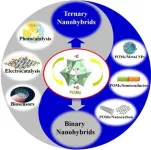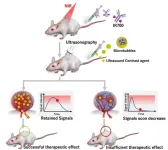(Press-News.org) LOS ANGELES — An international Phase 3 clinical trial found that metastatic colorectal cancer patients with a rare genetic tumor mutation called KRAS G12C experienced superior progression-free survival rates compared to standard of care when offered a combination treatment of KRAS inhibitor sotorasib and monoclonal antibody panitumumab. City of Hope, one of the largest cancer research and treatment organizations in the United States, was a participating site and a City of Hope researcher is the lead author of the The New England Journal of Medicine study published this week.
Standard chemotherapies often fail to control or eliminate the disease for patients with the KRAS G12C mutation, which is associated with a worse outcome. So, it is important to identify novel therapeutic options following disease progression on first- and second-line chemotherapy such as fluoropyrimidine, oxaliplatin and irinotecan.
“This is the first Phase 3 clinical trial to show a benefit over standard of care in patients with the KRAS G12C mutation whose cancer progressed after receiving standard chemotherapy. The efficacy results from our study are promising in this population with unmet needs and should set a new standard of care for metastatic colorectal cancer patients with KRAS G12C mutation who progressed following prior standard treatments,” said Marwan Fakih, M.D., professor in the Department of Medical Oncology & Therapeutics Research and the Judy & Bernard Briskin Distinguished Director of Clinical Research at City of Hope. Fakih is lead author of the new study and principal investigator of the clinical trial at City of Hope.
Building on positive results from a Phase 2 trial that evaluated sotorasib, a KRAS G12C inhibitor, in combination with panitumumab, an antibody targeting epidermal growth factor receptor, the Phase 3 trial evaluated the same duo of medications and tested sotorasib at two different doses. Participants in the randomized trial, all of whom had progressed on standard chemotherapy, were given either 240 milligrams of sotorasib with panitumumab, 960 milligrams of sotorasib with panitumumab, or standard of care therapy with anti-cancer medications (either a combination of trifluridine-tipiracil or regorafenib).
Both the lower and higher doses of sotorasib in combination with panitumumab met the goals of study by achieving a superior progression-free survival over the other anti-cancer medications. The higher dose regimen was particularly effective, more than doubling the median time to progression compared to standard of care, Fakih reported. Additionally, the higher dose regimen resulted in a far larger number of patients with major disease regression, “with response rate of 26.4% versus zero,” he added.
“While this study sets a new standard following progression on standard chemotherapy, additional studies will interrogate the value of this regimen when combined with standard chemotherapy in earlier treatment settings in patients with metastatic KRAS G12C mutated colorectal cancer,” Fakih said. “In addition, ongoing biomarker work will help better define mechanisms of resistance to this targeted combination and how to overcome such challenges.”
Funded by Amgen, the CodeBreaK 300 clinical trial is ongoing but no longer recruiting participants.
# # #
About City of Hope
City of Hope's mission is to deliver the cures of tomorrow to the people who need them today. Founded in 1913, City of Hope has grown into one of the largest cancer research and treatment organizations in the U.S. and one of the leading research centers for diabetes and other life-threatening illnesses. City of Hope research has been the basis for numerous breakthrough cancer medicines, as well as human synthetic insulin and monoclonal antibodies. With an independent, National Cancer Institute-designated comprehensive cancer center at its core, City of Hope brings a uniquely integrated model to patients spanning cancer care, research and development, academics and training, and innovation initiatives. City of Hope’s growing national system includes its Los Angeles campus, a network of clinical care locations across Southern California, a new cancer center in Orange County, California, and treatment facilities in Atlanta, Chicago and Phoenix. City of Hope’s affiliated group of organizations includes Translational Genomics Research Institute and AccessHopeTM. For more information about City of Hope, follow us on Facebook, Twitter, YouTube, Instagram and LinkedIn.
END
A research team has synthesized a new polyoxometalate-based metal-organic complex that they then tested as a catalyst for the oxidation reactions of various sulfides. They found that the complex possesses excellent catalytic performance, good reusability, and structural stability.
The team’s work is published in the journal Polyoxometalates on October 19, 2023.
Scientists in many fields have explored the selective oxidation of sulfides to sulfoxides. Sulfoxides are organic compounds that contain sulfur and oxygen. These sulfoxides are high value-added chemicals in pharmaceuticals, agrochemistry, ...
Sunscreen usage is climbing, but so are melanoma and skin cancer rates: this, researchers say, is the sunscreen paradox.
“The problem is that people use sunscreen as a ‘permission slip’ to tan,” said Dr. Ivan Litvinov, an Associate Professor in the Department of Medicine and Chair of the Dermatology Division at McGill University and co-author with Dr. Sandra Peláez, Dr. Richie Jeremian and Dr. Pingxing Xie of two recent studies that explore the sunscreen paradox.
“People think they are protected from skin cancer ...
Polyoxometalate (POM)-based nanohybrids potentially offer a step-change in sustainability across a wide variety of industries, but research into the substances is in its infancy. A group of researchers has produced a comprehensive review of the sector’s progress and challenges yet to be overcome.
A new class of nanoscale hybrid materials has the potential to improve sustainability across energy systems, transport, biosensors, water purification and even 3D printing, but the field is still very young. A group of researchers has produced a detailed overview ...
A clinical trial led by the ECOG-ACRIN Cancer Research Group (ECOG-ACRIN) demonstrates how diversity among study participants is vital for reducing outcomes disparities. Among the vast group of women participating in the TMIST breast cancer screening trial--nearly 93,000 so far--21% self-identify as Black or African American. This diversity offers hope that once the trial reaches its enrollment goal of nearly 129,000 women, its results can better inform and tailor future breast cancer screening for all women.
The TMIST breast cancer study is investigating whether screening for breast cancer ...
Severe Combined Immunodeficiencies (SCIDs) are a group of debilitating primary immunodeficiency disorders, primarily caused by genetic mutations that disrupt T-cell development. SCID can also affect B-cell and natural killer cell function and counts. Left untreated, SCID proves fatal within the first year of life. The conventional treatment for SCID patients involves allogeneic hematopoietic stem cell transplantation (HSCT), but the challenges of finding compatible donors and potential complications like graft-versus-host disease (GVHD) pose significant hurdles ...
A collaborative study involving researchers from Karolinska Institutet has charted the prevalence of severe physical symptom burden amongst Scandinavians for up to two years after a SARS-CoV-2 infection. Most affected were people who had a severe COVID-19 infection, while the researchers found no elevated prevalence of long COVID in those who had never been bedridden. The study is published in The Lancet Regional Health – Europe.
By mid-October 2023, over 771 million cases of COVID-19 had been reported to the World Health Organization (WHO). An estimated 10 to 20 per cent of the affected have persistent symptoms.
Close to 65,000 participants
In the present ...
Researchers at Nagoya University in Japan created and improved artificial intelligence (AI) designs to synthesize a candidate compound for a new gastric acid inhibitor with a better binding affinity than existing drugs. Their findings, published in Communications Biology, suggest a new way to work in tandem with AI to develop pharmaceuticals.
Stomach acid is a crucial component of food digestion. However, when the balance of gastric mucosal secretion is disturbed, stomach acid can cause discomfort and, in severe cases, conditions such as gastric ulcers and reflux esophagitis. Therefore, many people turn to gastric acid suppressants, most of which target the gastric ...
The optical frequency comb is an important tool in modern physics research and applications. In 2005, Theodor W. Hänsch and John L. Hall were awarded the Nobel Prize in Physics for their pioneering work on optical frequency comb technology. This sparked a great interest among researchers in the field, leading to a series of studies on optical frequency combs. Advanced nanophotonic technology has enabled integrated microresonators with ultrahigh Q factors and chip-scale microcombs. Among various comb dynamic states, a chaotic comb has high nonlinearity. In a chaotic comb, each comb tooth exhibits a chaotic dynamic ...
Researchers at Nagoya University in Japan and their collaborators have used a biomarker based on microbubbles to evaluate the success of near-infrared photoimmunotherapy (NIR-PIT) treatment. Using ultrasound to track the microbubbles, they were able to identify areas where cancer therapy had not been fully applied. Their findings suggest ways to improve NIR-PIT and make it a viable alternative treatment for various types of cancer.
NIR-PIT is an innovative cancer treatment that combines the use of antibodies and near-infrared light to ...
Up to 1.7 million people could be living with dementia in England and Wales by 2040 – over 40% more than previously forecast – finds a new UCL-led study.
Previous studies, based on data up to 2010, showed that dementia incidence had declined in high-income countries. However, the new research, published in The Lancet Public Health, indicates that dementia incidence started to increase in England and Wales after 2008.
Based on this estimated upward incidence trend, researchers project that the number of people with dementia in England and Wales may be significantly higher than expected in the future.
According to previous research* in England ...






